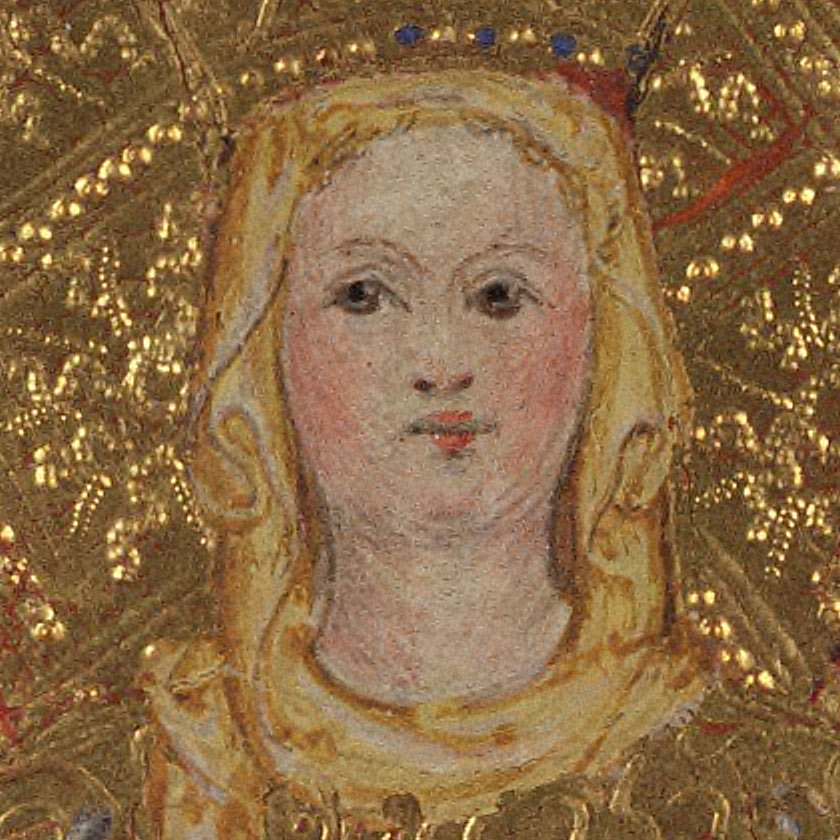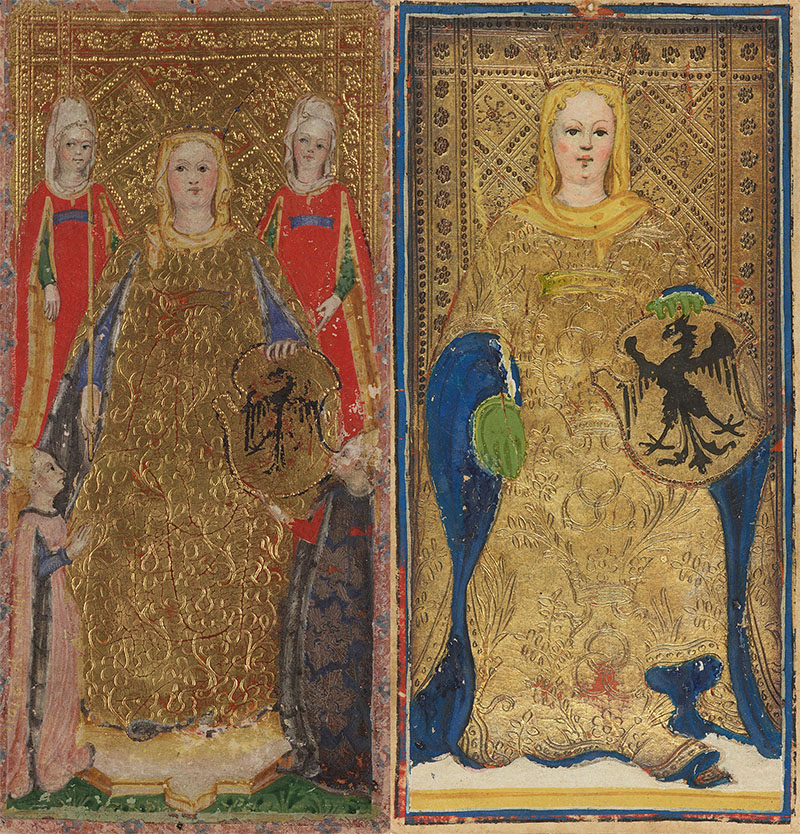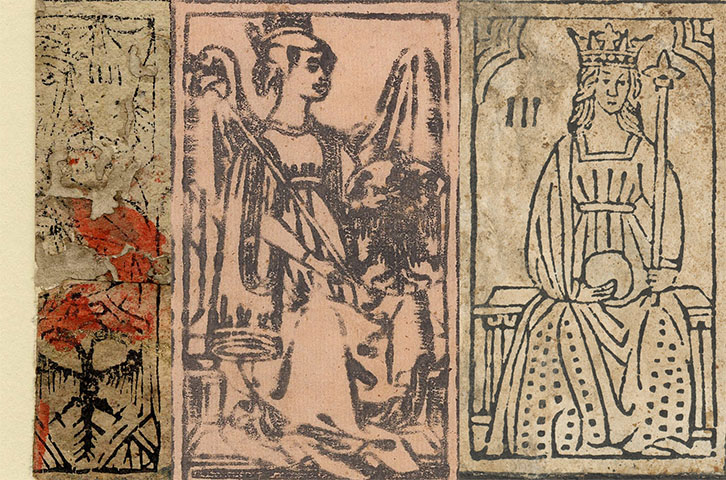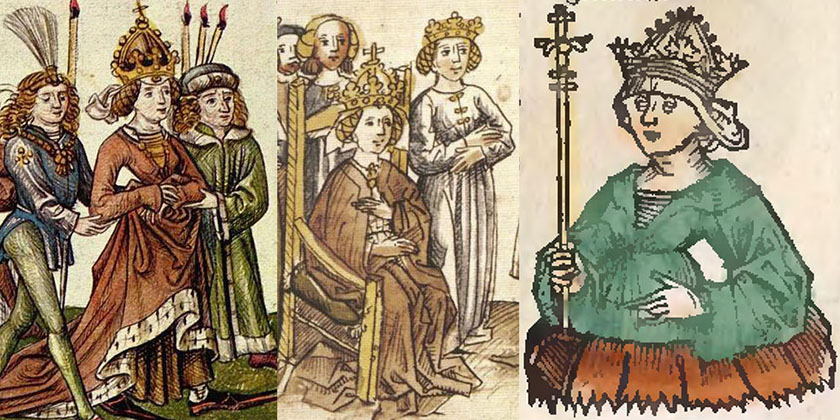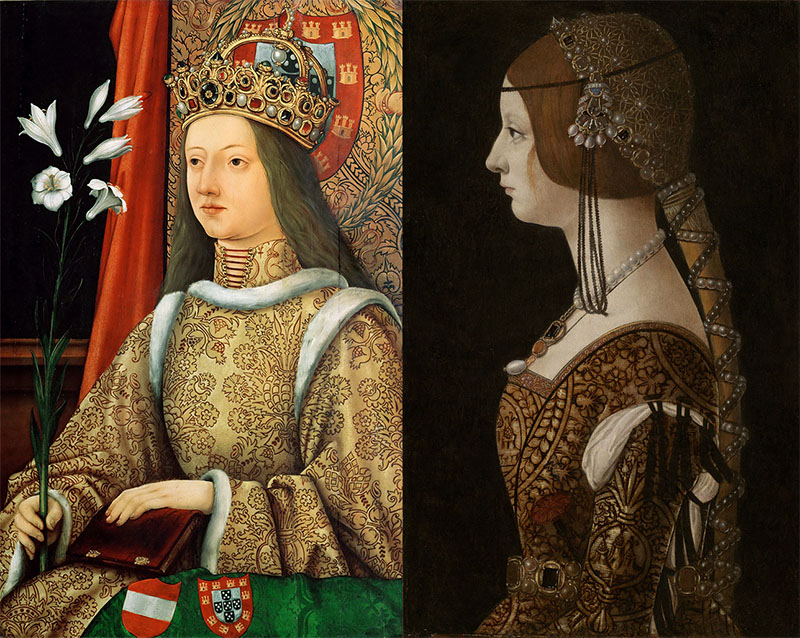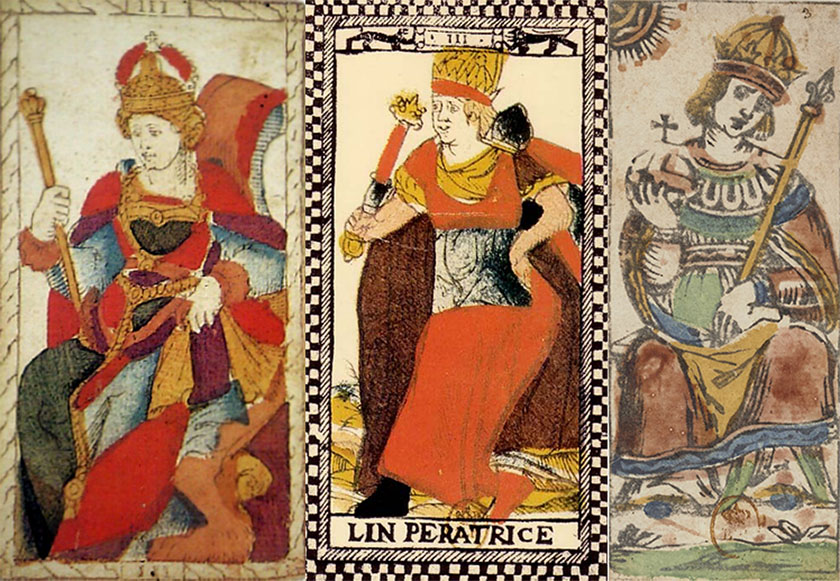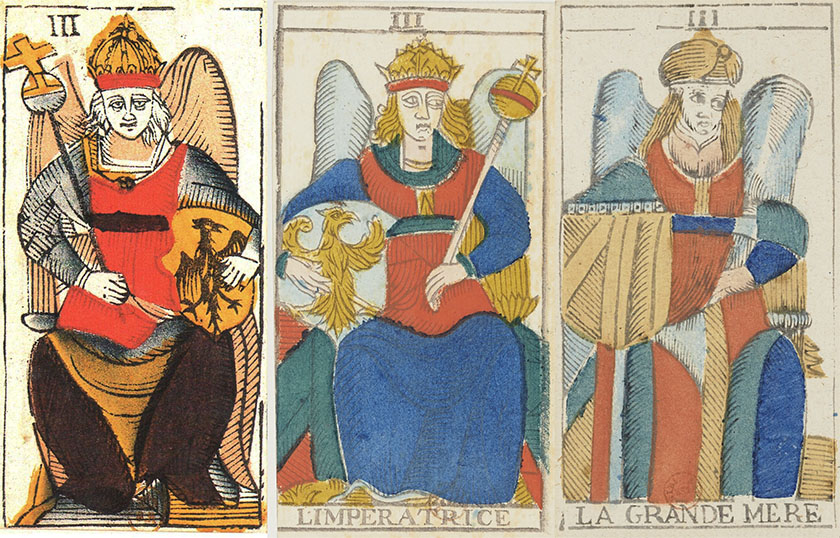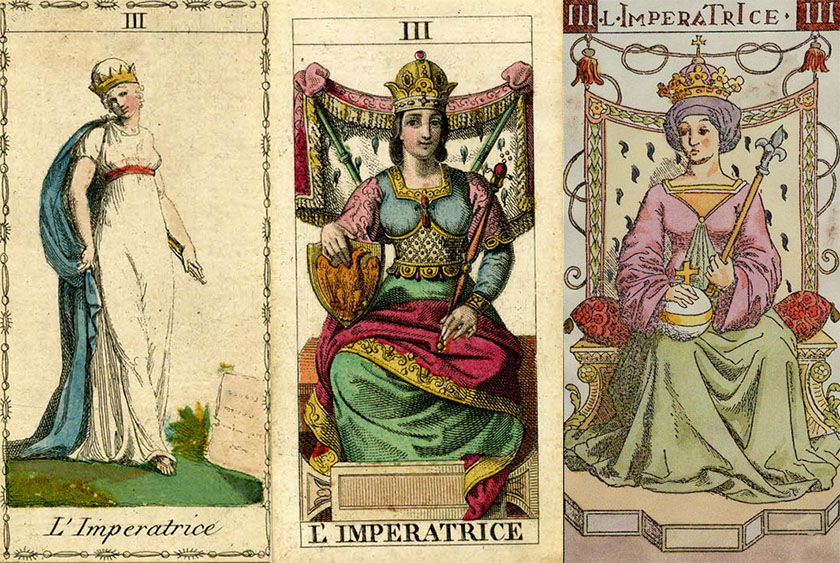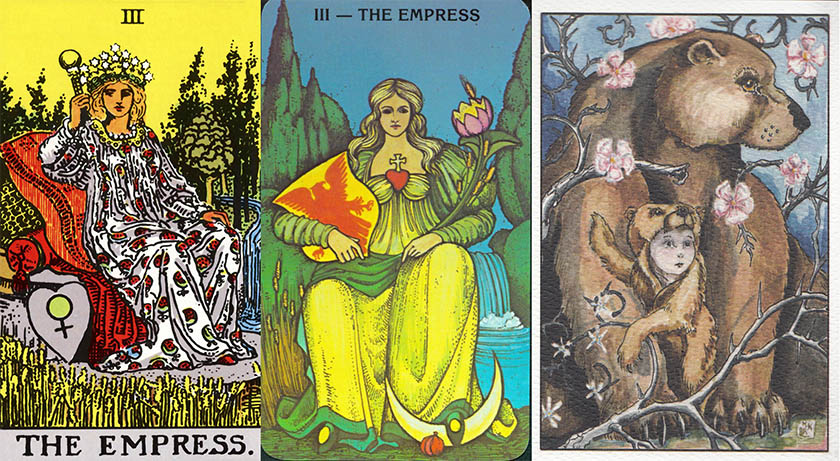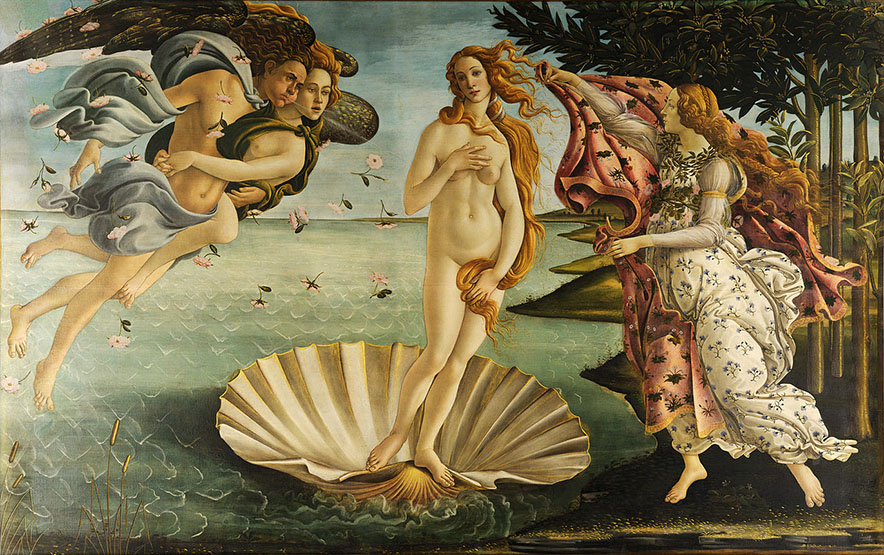THE TAROT WHEEL
IMPERATRIX - EMPRESS
A beautiful young lady in a golden gown, a golden yellow kerchief draped around her head. On her head, a golden crown with blue jewels on the border. On her lips and cheeks, a distinct red accentuation with natural pigments. The Lady is of a very high rank, and she is unreachable for the common human being. She is the Empress, and she incarnates motherhood and eternal youth. She symbolizes female perfection. On no painting you will find the Empress portrayed as an old woman, no, the Empress is always young, beautiful and far away. The image here above is a detail of the Empress card from the 1442 Visconti di Modrone Trionfi deck, conserved in the Cary collection of the Beinecke library at the Yale University.
There are only two hand-painted Empress cards that have survived the centuries. Both have been made by the same artist in order of the Milanese court. No Empress card from the Ferrara court survived time. The Mantegna engravings have only male figures on the society level. And also the Sola Busca trumps are male only. The second Empress card is part of the Visconti Sforza deck. The card is conserved in the Morgan Library. Here below both Empresses :
Two Empresses, two times the same Lady. On the left we see a lady sitting on a throne. She is wearing a golden gown. Her golden dress is covered with blossoms and has a blue lining. The blossoms were often used by Filippo Maria Visconti to indicate his own daughter, Bianca Maria Visconti. In her right hand she has a wand of power and in her left hand a "bouche shield" with the imperial eagle portrayed on it. The form of the bouche shield (or shield à bouche) is typical for the German countries and thus for the Holy Roman Empire. On her head is draped a yellow golden kerchief topped up by a golden crown. The Empress is sitting in a position that is frontally directed to us. She is surrounded by four girls. The two behind her identically dressed, maybe her daughters. The two girls in front of her have their hands raised to the Empress, as to serve her. The Empress is the mother of the children of the Emperor, and as such she incarnates motherhood and family. During the long absences of the Emperor it is the Empress who governs the court, as a mother, she is the head of the family.
Although there are approximately 12 years between the two cards, the portrayed lady is the same on the second card. Instead of blossoms we see now the triple ring, symbol for the Sforza family and the Piumai, a crown pierced by an olive and a palm branch, symbol for the Visconti family. She is wearing green gloves and the children have disappeared, for the rest the cards are identical. It is easy to identify Maria Bianca Visconti as the Empress. Many paintings are existing of Maria Bianca, on most of them she is portrayed as the virgin Maria with the child Jesus. And on all these paintings we see the same beautiful Lady.
Except for on the hand-painted cards, we also find the Empress back on several uncut sheets. Sometimes heavily damaged, sometimes in a good condition. Let us have a look at some of these sheets.
The card on the left, from the Budapest sheet, is heavily damaged and half of the card is missing. We can see that the Empress is facinc us. We also see the imperial eagle, double-headed this time. The Budapest sheet has its origins in Ferrara. The Dukes of Ferrara were Duke of Modena before becoming Duke of Ferrara. And as Duke of Modera they were part of the Holy Roman Empire. On the second card, from the Cary sheet, the Empress is not facing us anymore. This sheet has a Milanese origin. Except for the imperial shield and the wand, the details are difficult to recognize. The third sheet is from the Rosenwald sheet, that has its origins in Bologna. Bologna is one of the Papal states, so no imperial eagle on this card. As signs of power, the Empress has the Orb of Power in her right hand and the imperial wand in her left hand. She has no kerchief draped around her head, her hair is freely flowing.
So how was the Empress portrayed in Renaissance Art? Before looking at the images, first we have to consider who were the Empresses in this period. In fact, the Holy Roman Empire has a very complicated system to elect an Emperor. Theoretically the King of Germany would become Holy Roman Emperor, but in practice this was not so easy. So, roughly between 1350 and 1550 there have been only 5 Emperors : Charles IV, 1355-1378; Sigismund, 1433-1437; Frederic III, 1452-1493; Maximillian I, 1508-1518 and Charles V, 1530-1556. The most complicating factor was that the Pope had to crown the Emperor in Rome. However, Frederic II was the last Emperor crowned by the Pope in Rome. Maximilian I was never crowned by the Pope in Rome, he was only in 1508 elected Emperor, and bore as such the title. His grandson Charles V was crowned by the Pope, but in Bologna, not in Rome. Charles V managed to establish new coronation rules without the Pope. Since then, automatically when an Emperor died, a new one was crowned. This system would persist until the end of the 18th Century.
In the first half of the 15th Century, we were far from this simplified system, so there was no Emperor between 1378 and 1433. And who says no Emperor, says also no Empress. The title of Empress was linked by marriage to the title of the Emperor. Elisabeth of Pomerania, fourth spouse of Charles IV and mother of the later Emperor Sigismund, was Empress from 1363 to 1378, the year when the Emperor died. Although she was 31 years younger than her husband, their marriage was happy, and they had 8 children. As a mother, she reigned the Imperial family in the background, and we do not have images of her. There would officially be no new Emperor until her eldest son Sigismund was crowned in Rome in 1433, almost 40 years after she died. The last rightful Empress at the dawn of the Tarot, was the legal spouse of Sigusmund. She was called Barbara of Cilli, a Slovenian princess of the House of Celje, 24 years younger than her husband. She survived her husband with 14 years. Very few images are known of her.
All three images are from book illustrations. All three of them have in common that the artist probably never ever has seen an Empress in real. Therefor, we have some generic images of Barbara of Cilli from 15th Century artists expressing how they thought an Empress would look like. Barbara herself had the reputation of being a beautiful and intelligent woman, being skilled in alchemical arts.
The next Empress was Eleanor of Portugal, spouse of Frederic III and Empress from their coronation in Rome in 1452 until she died at an age of only 33 years in 1467. The woman who would be next to have the title of Empress was Bianca Maria Sforza, second wife of Maximillian I. She was a daughter of Gian Galeazzo Sforza, first son of Francesco Sforza and Bianca Maria Visconti. She would be Empress from 1508 until 1510, the year she died, 38 years old. Here below paintings of both Empresses.
When the cards of the Empress ware made, Bianca Maria Visconti probably would not have imagined, that her own granddaughter would one day become Empress of the Holy Roman Empire. Both Empresses have beautiful dresses and wear many jewels. The Empresses were rich, and they wanted to show it. Both had an unhappy marriage because of the big difference in character and age between the Emperor and his wife. There husbands were the Emperors Frederic III and Maximilian I, who were serious statesman, and both Empresses loved a luxurious life. They must have had a lot of money to spend, and they did not take life too serious. Both Empresses died before their husband who, in both cases deceived by their much younger spouse, did not marry again.
After these real Empresses, let us go back to the cards. The center of card making is shifting to the North (France) and to the South (Bologna and Florence). Here below a sixteenth Century French card and two early seventeenth Century cards, one from France and one from Italy.
From left to right the 1557 Empress of the Lyon based Catelin Geoffroy, the early 17th Century anonymous Tarot de Paris and the also early 17th Century Tarocchino di Bologna. On all three cards, a seated Empress is holding in her hand the wand of power. We see on her head the same type of crown we saw with Barbara di Cilli. On the Tarocchino card, she is also holding the imperial Orb of Power. On none of the cards, we see the imperial eagle, typical for the Holy Roman Empire. The Empress would not change a lot over the Centuries. She is a symbol, and the people had a clear image about how she should look like. That in reality the Empress was often a frustrated young Lady, married by force to a strange old man was something that the common people could not understand. For them, the Empress was an irreproachable Lady of high family, married to the most powerful man in Europe, mother of his heir and head of the Imperial family when receiving guests or when conducting parties.
In France, the figure of the Empress would crystallize in a standard format. The first who used this format was Jaques Vievil, who designed around the middle of the 17th Century his Tarot is Paris. We see the Empress with her typical imperial crown, the wand of power surmounted by the imperial Orb in her right hand and a shield with the imperial eagle in her left hand. On the Marseille Tarot, the image got mirrored, but did not change. The example here is from the Tarot of Nicolas Conver, designed in 1760 in Marseille. For centuries, the image would not change, only to be disturbed in 1793 by the French Revolution. In the years immediately after the French Revolution everything what seemed to be royal had to lose its nobility, and the Tarot was no exception. When in 1794 François Isnard made his Tarot deck in Strasbourg, many figures changed name and/or appearance. The Empress we see here became the Grandmother. But this change would not last and well before the turn of the century she would be Empress again.
In Italy; the Empress continued to have here proper appearance. Always young, always crowned, with a wand and an orb of power. From left to right we have here a Tarocchino card of Mitelli, a Minchiate card from Bologna and a Minchiate card from Florence. The four society cards (Empress, Emperor, Popess and Pope) had the same value in game playing in Italy. Usually, they were called the four Popes. In 1725 in the Tarocchino game they were exchanged with four Moors, so the Empress disappeared from this game.
Also in the 19th Century, the North Western Italian Tarots continue to distinguish themselves from the uniform French design. Next to the Piemont Tarots, closely related to the French design (the Tarot of Marseille), many other designs continued to flourish. On the left side, we have at left the early 19th Century Milan-made so-called Tarot of Lombardy. The next one is from the same period and town, the della Rocca design. On this card made in Milan we'll find again the shield with the imperial eagle. At the far right we have the Tarot of Giovanni Vachetta made in Torino. For this last deck, that dates from 1893, the original design is without colors, it was left to the card makers to interpret the cards with their proper colors.
And here ends our tour around the Empress in the Tarot. From left to right the 1907 Rider-Waite-Smith Tarot, the Morgan Greer Tarot, designed by William Greer and published in 1979 on the Morgan Press and the Stolen Child Tarot designed in 2012 by Monica Knighton. The design of the Empress card did not change over the ages, but in the modern Tarot the artist is only limited by his (her) fantasy. The Empress is the symbol for the eternal mother, the head of the family, responsible for the education of her children. She expresses love and authority at the same time. The Empress is the card that expresses best the pure feminine principles. One picture can tell more than a thousand words, so let us finish with an image expressing the best these female principles.
